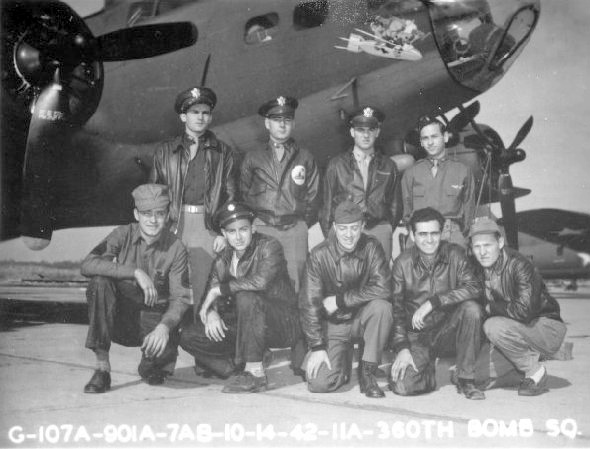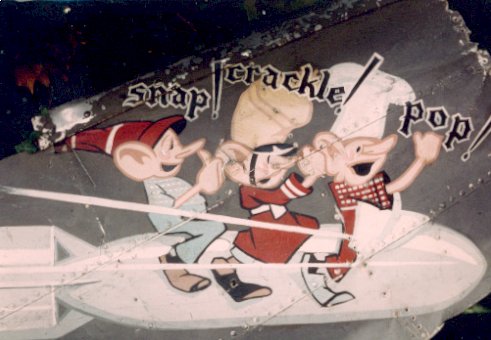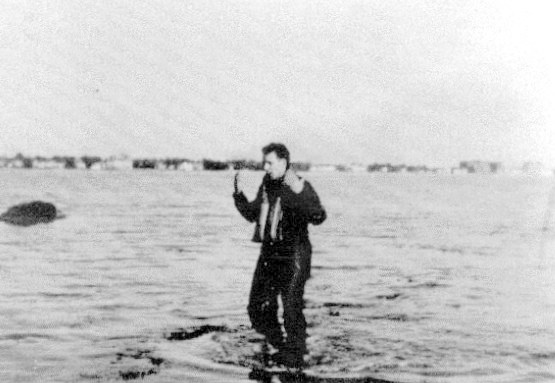
The original crew 10/14/42.

The original nose art.

S/Sgt. Alan Magee
Posted on 10/04/2012 6:12:35 PM PDT by robowombat
The Free-Fall of Sergeant Magee January 3rd, 1943 Over Saint-Nazaire, France
The war-torn skies over Europe were the scene of numerous acts of heroism, bravery, and courage. On a daily basis, men on both sides fought hard, wagering life and limb, in pursuit of the glory of their respective nations. In late 1942, the United States Army Air Forces had begun a campaign of daylight precision bombing raids over central Europe, determined to destroying the production and manufacturing infrastructure of the Third Reich.
In September of 1942, ground elements of the 303rd Bombardment Group (Heavy) arrived and set up base at RAF Molesworth in England, with their aircraft, Boeing B-17F "Flying Fortress", arriving from the United States the following month. But before leaving the U.S., Captain Jacob W. Fredericks of 360th Bomb Squadron, who had before the war worked as the Director of Engineering Development at the Kellogg Company, added a personal touch to the bomber he would be ferrying across the Atlantic. A design artist friend of Fredericks' painted the likeness of Snap, Crackle, & Pop, the promotional mascot/slogan of one of Kellogg's cereals, Rice Krispies, on the nose of his bomber.
By January of 1943, the air war was seemingly won by the Allies. The raids would continue, however, to soften the Nazi's "Atlantic Wall" for the coming invasion.
Short But Sweet...
Alan Magee was born 13 January 1919, in Plainfield, New Jersey, as the youngest of six children. Living in Somerset, New Jersey, after the disaster at Pearl Harbor in 1941, he enlisted at the recruiting office of the Army Air Corps in Newark.
He was 5-foot, 6-inches, in height, and 155 pounds in weight, making him the perfect size for a highly valued and unique position in the service of his nation - that of a ball-turret gunner. The new B-17 had a new innovation on it - the Sperry Ball Turret - a pair of M2 Browning machine guns capable of firing in a 360-degree arc, mounted on the bottom of the 'Flying Fortress."
The gunners had to be small for the cramped confines of the ball turret. A gunner's knees were practically against his chest, and the lack of space provided no room for the gunner's parachute. The space was so compact, ammunition to the guns was feed from outside the ball through a series of connective ducts.
Daytime Raid...
On January 3rd,1943, Magee's B-17 crew was on a bombing run on Saint-Nazaire, France - aka "Flak City" - due to the heavy concentrations of anti-aircraft artillery in and around the town. It was Magee's seventh mission into combat. He was one of the oldest members of the 10-man crew, as the pilot, Captain Arthur Adams, was only 19, and this was only his third combat mission.
"There was not a cloud in the sky, it was a beautiful day," Magee recalled some years later. But not for long.
Saint Nazaire was the location of a heavily fortified U-boat submarine base that was built shortly after Nazi occupation of France. Its 9 meter thick concrete ceiling was capable of withstanding almost any bomb in use at the time, and the U-boat threat to supply convoys across the Atlantic made Saint-Nazaire a constant target of Allied air forces
The target for the mission was the torpedo storage area near the submarine port in Saint Nazaire. The 360th Bomb Squadron sent 17 'Flying Fortresses', as a part of an overall attack of 85 B-17s with a fighter escort, to demolish the facility. Among the B-17s in the attack was the "Memphis Belle", the first bomber in the U.S. Eighth Air Force to complete 25 missions as a crew over Europe Over Saint Nazaire, the formation of bombers encountered heavy flak, and two dozen German fighters, intent on repelling the Americans. An intense firefight ensued, and in the havoc, a flak shell hit and exploded in Magee's ball turret.
"We were hit by anti-aircraft guns, but what knocked us out of the sky was a Focke-Wulf FW 190 shooting our wing off," Magee said. "The last thing I remember was that I was at 20-some thousand feet trying to get out of a burning plane."
Magee, who was wounded by the explosion that rendered his turret inoperative, climbed out of his turret to discover that the chest parachute he wore has a sizable hole in it, making it useless. Tossing it to the floor, Magee made his way to the bomb bay to wait for the radioman to bail out, when the bomber was simultaneously struck by German fighters, shooting off a section of the aircraft's right wing, and the boom of another flak explosion.
From Bad to Worse...
The plane was catapulted into a spin. Magee, wounded again from the second flak shell, tried to proceed up to the radioman's station to grab him so they could both bail out. But, at 20,000 feet above the earth, Magee blacked out from hypoxia (lack of oxygen). The physics of flight, however, kept Magee tumbling, and a gap, blown open in the fuselage by the flak, became the point at which Magee departed from the bomber. The wreckage of the bomber would later crash near Baule les Pins, France.
The Railroad Station in Saint Nazaire Meanwhile, Magee recalled the sensation of free-falling, and thinking he asked for divine intervention to save his life. "I don't wish to die because I know nothing of life" was his appeal, as he slipped into total unconsciousness, drifting down to earth at a speed of nearly 120 MPH.
A couple of minutes later, Magee crashed through a skylight at the train station in Saint Naziare. Ensnared among the steel girders, Magee was cut down, and taken in custody to receive medical attention. Upon regaining consciousness, Magee is reported to have said, “I don't know how I got there, but here I am, thanks to God."
Magee's injuries included 28 shrapnel wounds, resulting in a punctured lung and kidney, his nose and one eye being ripped open, several damaged teeth, his right arm nearly severed from his body, and a broken right leg & ankle. Magee was taken to the Hermitage Hotel in town where, according to Magee, a doctor stated, "We are enemies, but I am first a doctor and I will do my best to save your arm." Magee never found out the name of the doctor, a German, who saved his arm, and took care of his numerous injuries.
Magee recovered after a two and a half month hospitalization, but then was transferred to a normal "prisoner of war" camp.
Magee - known to some as the "Miracle of Saint Nazaire" -credited the many layers of clothes he was wearing - long-johns, an electric flight suit, his uniform, jumpers, and a heavy flight jacket - as having helped save his life.
Two of Magee's crewmates managed to successfully bail out of their B-17 before the crash - Lt. Glen M. Herrington, the navigator of the crew, and Staff Sergeant James Gordon, the tail gunner. Herrington and Gordon parachuted into the waters of the English Channel, landing 30 meters from the Bay of La Baule Pins Beach, and were rescued by German troops. Suffering a severely wounded leg, Herrington's leg was amputated by doctors at the Luftwaffe hospital . After his recovery in the hospital, he was sent to an interrogation center, and in October of 1943, he became one of the first Americans to be repatriated. After a journey through four countries, he arrived at a Washington, D.C. hospital. Herrington would later marry the nurse who treated him in that hospital.
At the end of the day, it had been a costly raid, as 75 airmen from the 303rd BG were killed that day. Of the 85 in the attack, seven B-17s were shot down, and 47 were damaged.
Since no one on the Allied side saw the fall of Magee, or knew the fate of the aircrew, a "Missing Air Crew Report", or MACR, was filed with the War Department. Filed as number 15464, it is one of the few documents pertaining to the fate of the bomber still in existence.
After the War...
The Crew of B-17F #41-24620 'Snap! Crackle! Pop!' on January 3rd, 1943
Duty Position Name Rank Status post-mission Pilot Arthur I. Adams Capt KIA Co-Pilot Gene A. Witterstetter 2nd Lt KIA Navigator Glen M. Herrington 2nd Lt WIA/POW Bombardier Michael L. Libonati Jr. 2nd Lt KIA Flight Engineer Lewis C. Hart T/Sgt KIA Right Waist Gunner Edward W. Durant S/Sgt KIA Radio Operator Alfred M. Union T/Sgt KIA Ball Turret Gunner Alan E. Magee S/Sgt WIA/POW Left Waist Gunner Marvin L. Milam Sgt KIA Tail Gunner James I. Gordon S/Sgt POW
The German army surrendered in early May of 1945. Magee was liberated in May 1945 and received the Air Medal for meritorious conduct and the Purple Heart. Magee earned his pilot's license in 1946, and worked in the airline industry, including air freight and airline reservations, in a variety of responsibilities. He retired in 1979 and moved to northern New Mexico.
His incredible story was featured in 1981 in a "Smithsonian Magazine" story on the 10 most amazing survivals during World War II.
On January 3rd,1993, fifty years after his fall, the people of Saint Nazaire honored Magee and the crew of his bomber by erecting a 6-foot tall memorial to them.
In late September of 1995, Magee and his wife, Helen, visited Saint Nazaire for the first time since his wartime experience. He was part of the dedication of a "stele," or commemorative pillar and memorial plaque, funded by Michel Lugez and the American Memorial Association, near the bomber's crash site, as well as a tree planting, and a visit to the American cemetery in Normandie. As part of the trip, Magee visited the railroad station that he fell onto, and stated, "I thought it was much smaller."
Magee seldom spoke of that death-defying drop. Alan Magee died in San Angelo, Texas, on December 20th, 2003 from stroke and kidney failure at the age of 84, and was buried at Pioneer Memorial Park.
Relics of War...
Pieces of the B-17 "Snap! Crackle! Pop!" survive the war and retain their provenance. A section of the crashed fuselage, the portion showing the starboard side noseart, was cut from the fuselage by the Germans, becoming a 'war trophy.' The chunk of fuselage decorated the wall of a local villa called 'Georama' - an important estate next to St. Marc Sur Mer - which was used by the Nazis as a headquarters.
At the end of the war, before they were captured, the Germans threw the piece off a cliff into a ravine, along with an RAF aircraft bomber's company crest. They were recovered by a French passerby, and are now located in a museum in Saint Nazaire.
Lemay mentions the 305th lost two B-17's on this raid but dseems unaware of the saga of Sgt MaGee.
Unlike in Korea or Viet Nam captured injured USAAF personnel were treated as well as personnel from the GAF would have been.
I read that story quite a few years ago. I did not realize he was so badly hurt tho.
Around 20 years ago, a paratrooper dropped on a training mission at Eglin AFB. His chute did not open but he fell in a muddy field and miraculously survived.
In those days I would go (with parents) a half block away to a big bar that was the first place to get a drink after leaving Biggs. There I listened to many a story from newly discharged AF pilots, gunners, mechanics, etc - many wounded with missing legs, arms.
One of them lost a leg after his plane came apart, he fell out of the sky with no 'chute' and landed on a barn-roof, then a large pile of hay inside.
I heard a great number of stories in those days, a few of them making a near-indelible life-long impression on memory.

The original crew 10/14/42.

The original nose art.

S/Sgt. Alan Magee
I've always regretted that I never got a chance to hear about it from him.

Tail gunner S/Sgt James Gordon bailed out of the same B-17 as Magee and landed just off the beach where he was assisted ashore by a couple Frenchmen and taken prisoner by Germans. An unidentified Frenchman took the photo. It is presumed that he died in a POW camp as no further word was ever received of him.
Disclaimer: Opinions posted on Free Republic are those of the individual posters and do not necessarily represent the opinion of Free Republic or its management. All materials posted herein are protected by copyright law and the exemption for fair use of copyrighted works.